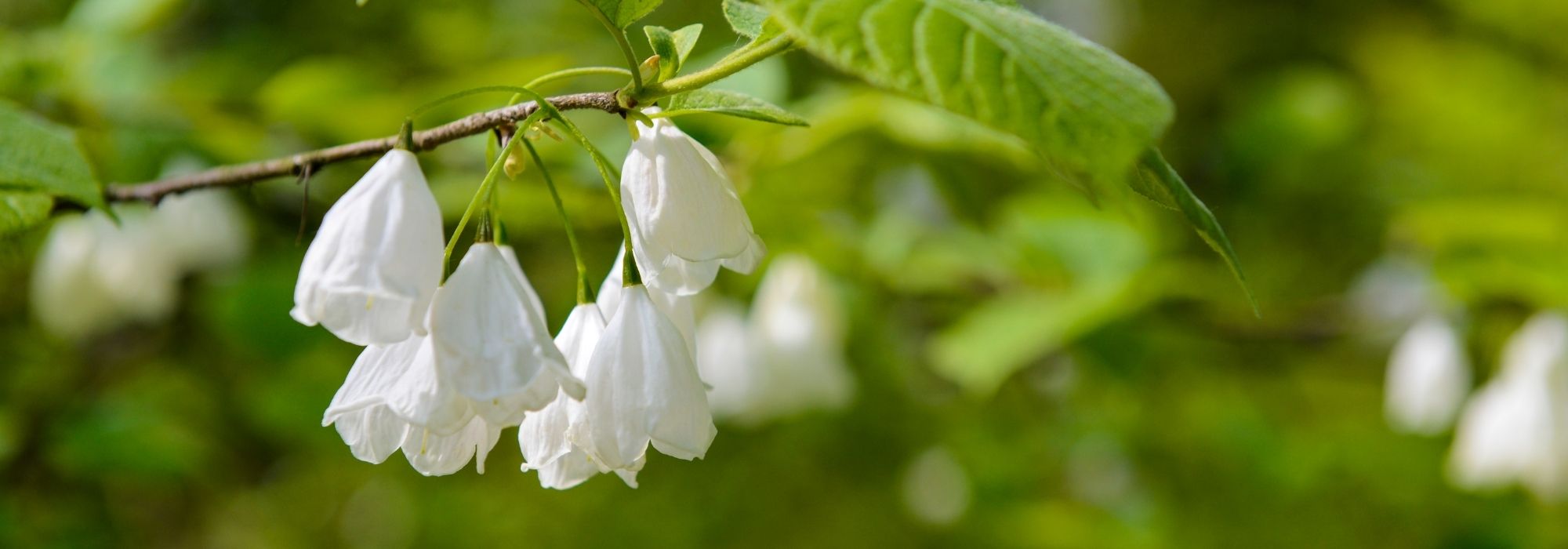
Halesia, Silverbell: planting, growing
Contents
Halesia in a nutshell
- It is a large hardy bush, ornamental, very floriferous and rare
- Its spring flowering features delicate white bell-shaped flowers that are abundant
- Its bright green foliage in spring turns a beautiful yellow in autumn
- Fast-growing, it can reach 6-8 m in height in slightly acidic soil and in a semi-shaded position
- It is easy to grow in borders or as a specimen
A word from our expert
Still too rarely cultivated, Halesia, also known as the “Snowdrop tree” or “Carolina silverbell,” is a stunning small, hardy, and vigorous tree. It deserves to be planted more in our gardens for its remarkable ornamental qualities from spring to autumn. From April to May, Halesia carolina and Halesia monticola display a beautiful flowering in the form of lovely pendulous white bells, followed by decorative winged fruits. In autumn, their deciduous leaves turn a lovely golden yellow. The Halesia monticola ‘variegata’ stands out with its very bright variegated foliage.
Easy to grow and perfectly hardy, it thrives in partial shade in cool soils, preferably free of lime.
With its elegant habit, it easily finds its place as a specimen on a lawn or at the back of a bed of acidic soil shrubs.
Discover everything you need to know about this superb, unusual shrub!
Botany
Botanical data
- Latin name Halesia
- Family Styracaceae
- Common name Halesia, Silverbell, Little silverbell, snowdrop tree
- Flowering April to June
- Height 2 to 10 m
- Exposure Sun, Partial shade
- Soil type Heather (Acid), neutral, well-drained, moist
- Hardiness -15 to -20°C
Halesia, also known as silverbell is a deciduous and vigorous tree native to the moist forests and mountains of the southeastern United States and China, belonging to the family Styracaceae. The genus comprises only 5 species of trees or shrubs, primarily the Halesia carolina and the Halesia monticola or Mountain Halesia. Both have given rise to about ten cultivars distinguished by the size, number, or colour of their flowers.
Growing rather slowly, Halesia forms a very elegant tree with a spreading habit, typically featuring a wide, conical crown. It can reach heights of 8 to 10 metres in its natural habitat, but rarely exceeds 4 to 8 m in our latitudes, with a width of 2 to 8 m. It often forms multiple trunks. Over the years, the beautiful brown bark exfoliates in fine strips, revealing very decorative grey and black stripes.
Halesia boasts a remarkable spring flowering that appears just before the leaves, almost completely covering the previous year’s wood. From April to May, the Silver Bell Tree is then enveloped in an avalanche of axillary clusters of large pure white or slightly pink bell-shaped flowers, suspended from the branches. Grouped in clusters of 2 to 6, they consist of pendulous, campanulate corollas with four petals measuring 1.5 to 5 cm in diameter. Enclosed in a chartreuse green calyx, they reveal a bouquet of yellow stamens and bloom for 8 to 10 days. This flowering, reminiscent of snowdrop flowers, blankets the foliage like a floccose cloud, earning Halesia its nickname “Snowdrop Tree”.
In summer, these small bells are followed by curious winged fruits, ovoid and pendulous drupes measuring 2 to 4 cm long, initially green then brown, containing 3 to 4 seeds and persisting throughout winter on the bare branches.
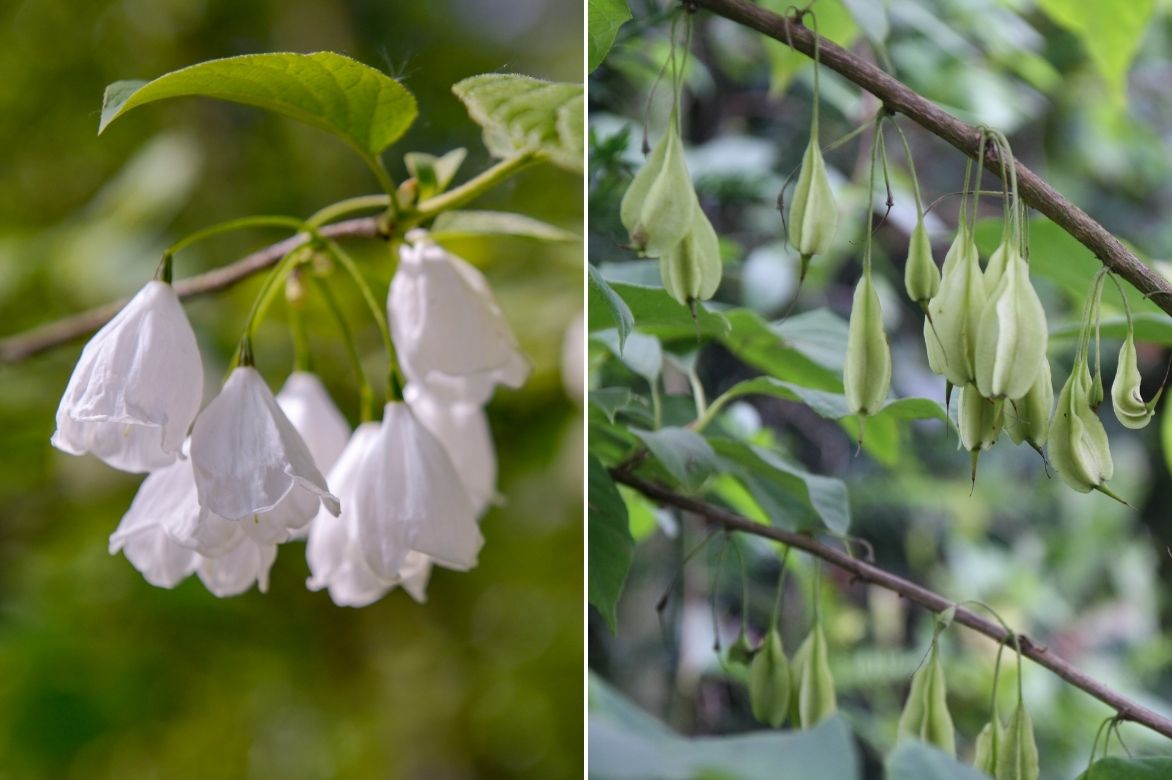
Halesia carolina: pendulous bell flowers and fruits
In spring, the fine branches are adorned with beautiful deciduous foliage that varies significantly from one variety to another. The alternate leaves, oval to elliptical, more or less acuminate and finely dentate, sometimes crinkled, measure 7 to 15 cm. The Halesia monticola features slightly larger leaves. Initially velvety in their juvenile state, they later become glossy on the upper side and remain more or less villous on the underside. Generally green, the cultivar ‘Variegata’ is distinguished by its beautiful light green foliage edged in cream yellow. They turn golden yellow or red in autumn in the Halesia monticola var. vestita rosea.
Main species and varieties
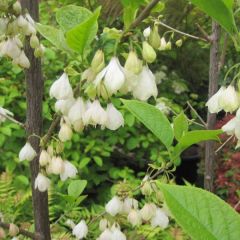
Halesia carolina - Carolina Silverbell
- Flowering time June, July
- Height at maturity 6 m
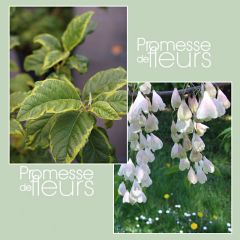
Halesia monticola Variegata
- Flowering time May, June
- Height at maturity 4 m
Discover other Halesia
View all →Available in 1 sizes
Available in 1 sizes
Available in 2 sizes
Available in 1 sizes
Planting Halesia
Where to plant it?
Hardy down to -15 to -20 °C, Halesia is not afraid of the cold, but it prefers a location well sheltered from cold winds. Late frosts can damage its delicate spring flowering. It particularly enjoys a humid atmosphere and a shaded position. It thrives in fresh to moist, well-drained humus-bearing soils, with a preference for rather acidic, non-calcareous soils. It is said to prosper only in acidic soils, but it will adapt to any good deep garden soil, even slightly calcareous and well-drained.
It shares similar requirements to heather soil shrubs. It needs soil that retains some moisture, even in summer, and will not tolerate dry, overly calcareous soils. If your soil is heavy, compact, or clayey, consider adding pumice or gravel to improve drainage, which will also help prevent the onset of fungal diseases.
Choose its location carefully as it dislikes being moved.
With its natural elegance, Halesia can be used both as a specimen plant to enhance the background of a border with heather soil shrubs.
When to plant it?
Plant Halesia in autumn, from September to November, to encourage rooting, or in spring from February to April, avoiding frost periods.
How to plant a Halesia?
In the ground
Halesia appreciates deeply worked soils with well-decomposed potting soil or compost and well-drained materials (stones, gravel…).
- Dig a large hole 2 to 4 times the size of the root ball
- Make a good bed of gravel at the bottom of the hole
- Add a mixture of potting soil, well-decomposed compost, coarse sand, and heather soil
- Place the tree
- Stake it securely
- Fill in while keeping the plant upright
- Lightly compact at the base
- Water generously
- Mulch the base to keep the soil cool in summer
Pruning and care
Halesia is a small, easy-to-cultivate tree that shows no diseases and requires almost no maintenance.
Monitor water needs, especially in the first few years and during dry spells. It is advisable to mulch around the base in spring to maintain some moisture in summer: the soil will stay cool for longer, and your tree will require less watering.
In hot and dry weather, do not hesitate to shower the foliage of young plants recently planted.
Halesia will also benefit from a spring application of fertiliser or well-rotted compost to stimulate growth and flowering.
Pruning is not necessary, especially since flowering only occurs on old wood. A light annual shortening of long shoots is sufficient to balance its branches and maintain a lovely bushy silhouette. This should be done once flowering is finished: remove dead, damaged, or poorly placed wood. You can also cut back low branches if you wish to keep only a single trunk.
Propagation
If Halesia can be multiplied by sowing, we recommend propagation by cuttings in May-June, which remains quite difficult to achieve, or layering, which is less risky.
By herbaceous cuttings under glass
- Take 20-centimetre-long shoots from the current year’s growth
- Remove the leaves from the bottom of the cutting, leaving only a few at the tip
- Plant the stems in pots filled with a mix of potting soil and sand or perlite, firming lightly, then water
- Cover the pots with transparent plastic bags and place them out of direct sunlight, at a temperature of around 20 °C
- Water regularly to keep the substrate moist
- Transplant these cuttings once they are well-rooted
Layering
You can also perform layering by pegging down in September;
- Bend the long low stems to the ground,
- Remove the leaves and scrape the bark for 10 cm on the underside of the branch
- Lay the branch in a furrow dug in the soil nearby and bury part of the stem to encourage rooting
- Fill in the furrow and hold the layer in place with metal hooks
- Raise the end of the branch and stake the aerial part to keep it upright
- Water
- Separate the layer from the mother plant once it is well-rooted, two to three years later
- Then replant immediately in the ground
Pairing ideas with Halesia
With its elegant silhouette, Halesia brings a touch of freshness to natural gardens at the end of spring. Enjoy its elegance as a standalone in the middle of a lawn, at the back of a large bushy border, or planted within a group of bushes.
Pair it with ericaceous plants, deciduous Azaleas, Rhododendrons, viburnums, witch hazel, Styrax, Camellias or Pieris that have the same growing requirements.
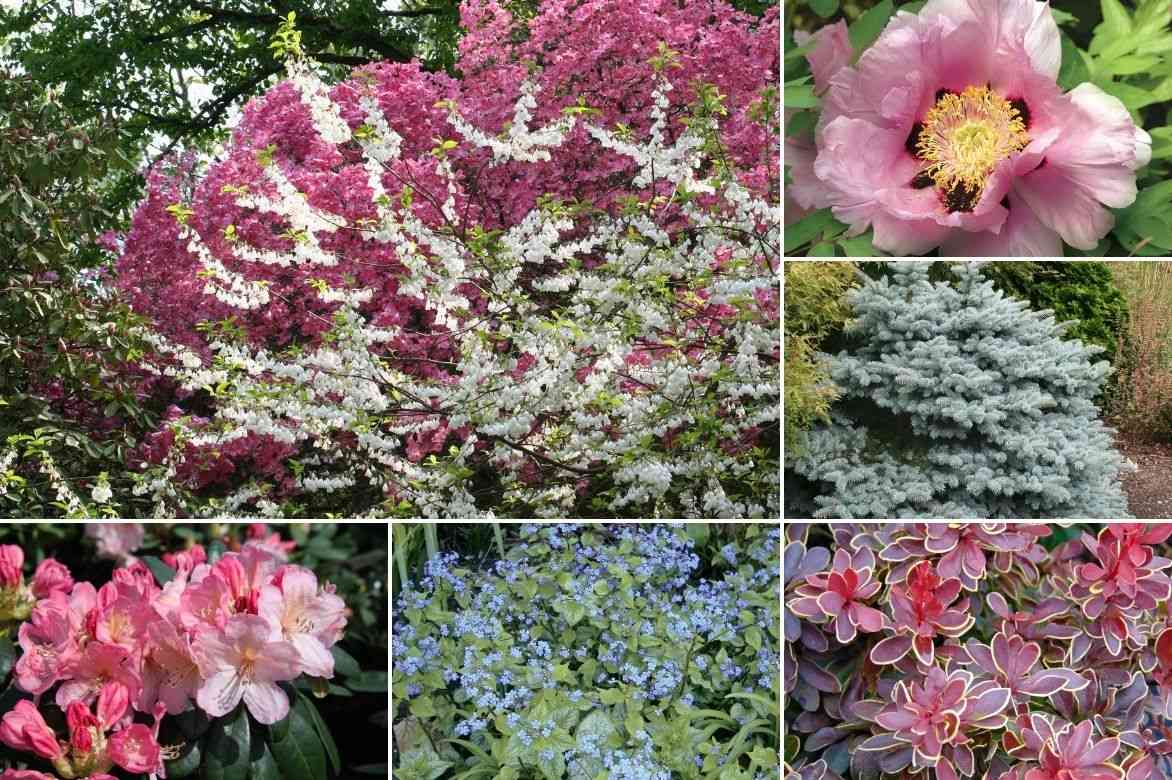
An idea for pairing: Halesia carolina and Cornus kousa ‘Satomi’, Paeonia suffruticosa ‘Lilac’, Picea pungens ‘Glauca Globosa’, Berberis thunbergii ‘Admiration’, Brunnera macrophylla ‘Jack Frost’, Rhododendron yakushimanum ‘Percy Wiseman’
In spring, simply surround it with spring bulbs or spring-flowering perennials, such as white daffodils, alliums, Eremurus, erythroniums or late tulips.
To complement its golden foliage in autumn, it may be wise to pair it with trees that have colourful foliage, such as a Purple Birch, Japanese Maple, Deciduous Euonymus, or Amelanchier Lamarckii.
Useful resources
- To accompany it, discover our acidic soil shrubs that pair well with it!
- Here are 5 tips to successfully grow acidic soil shrubs
- Subscribe!
- Contents
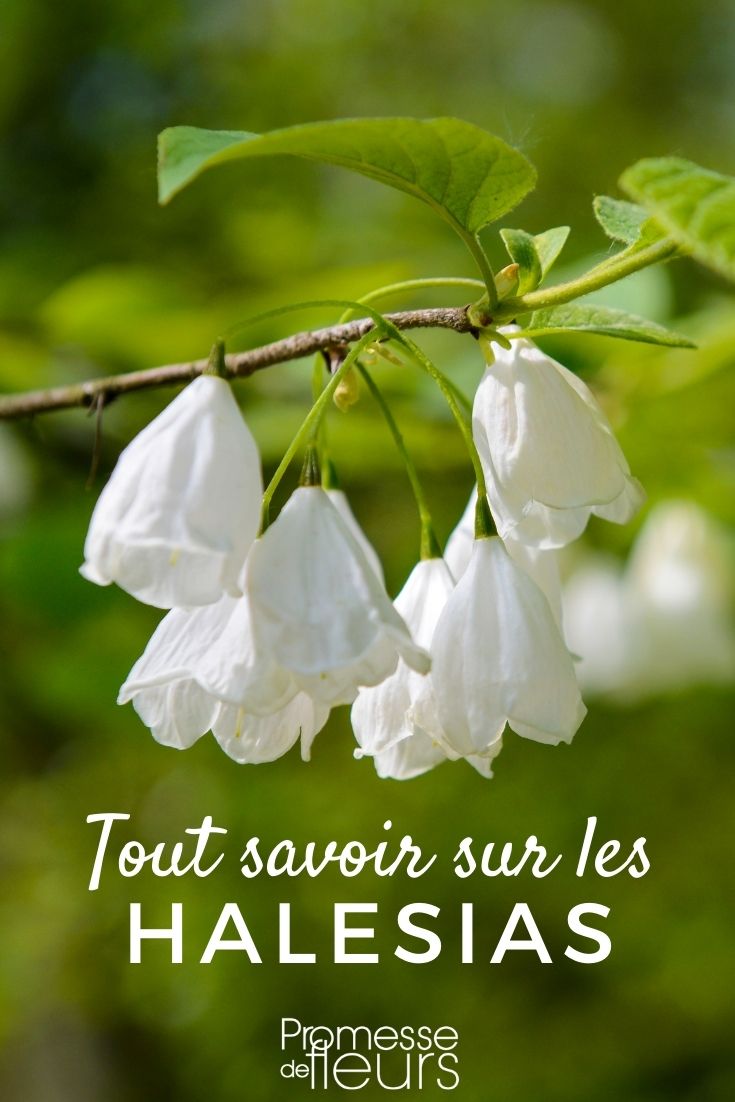































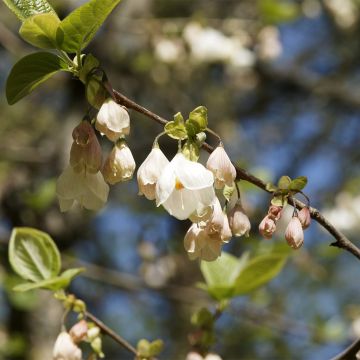



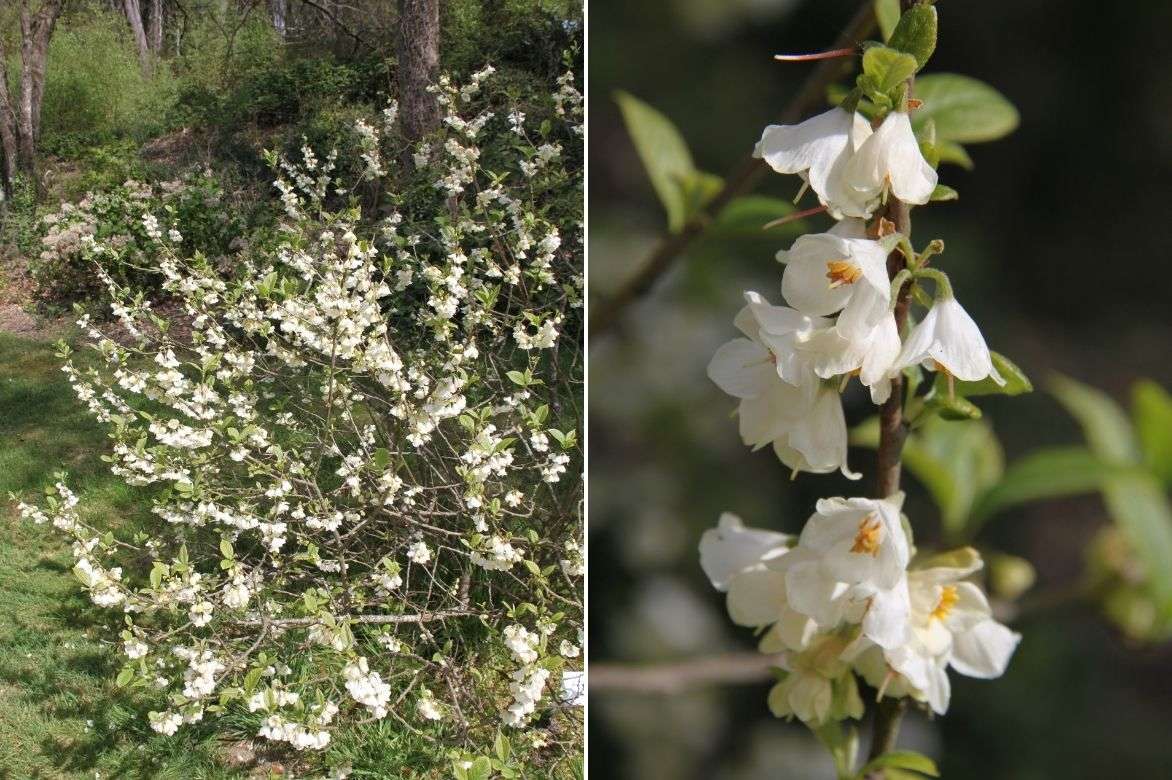
Comments